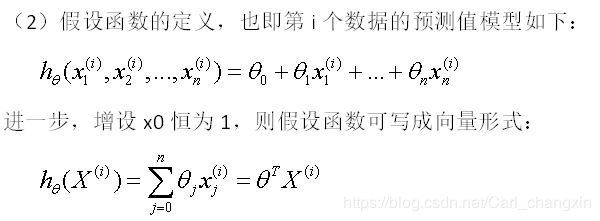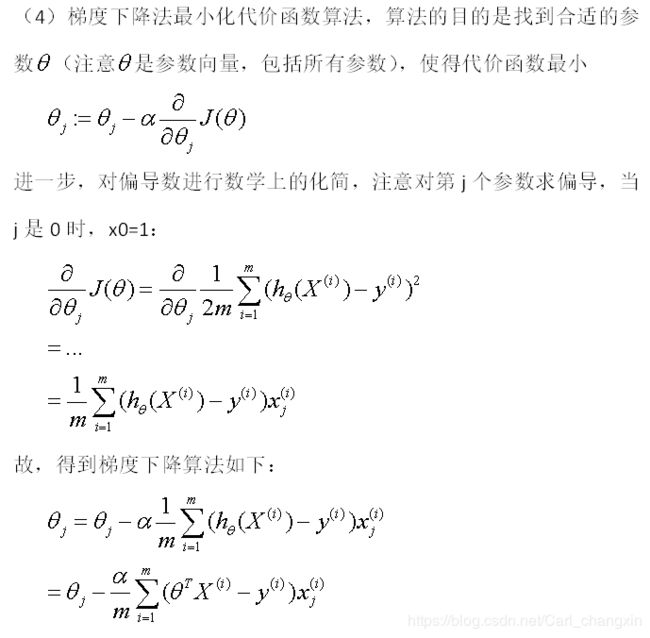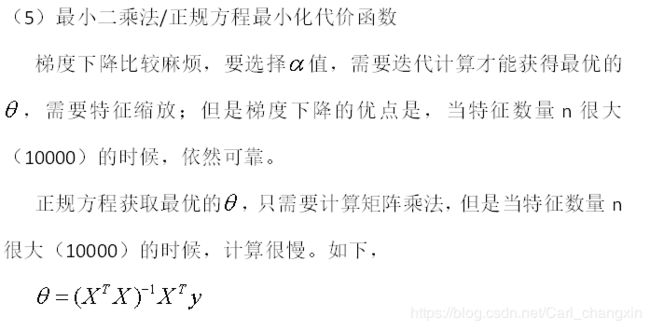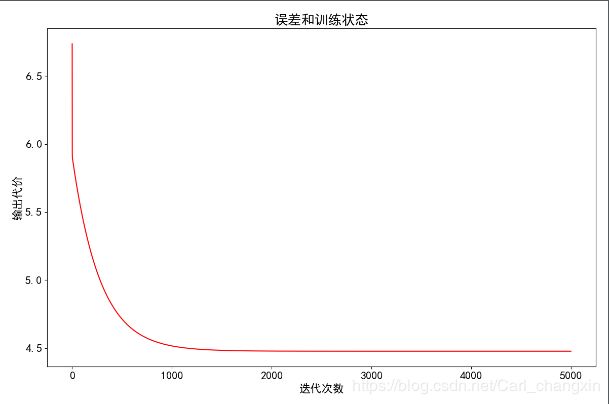python实现线性回归算法
前言:学习了吴恩达机器学习线性回归部分内容后,再结合很多优秀博客总结,搬运出来的干货。
1、原理
2、单变量线性回归
数据准备:https://blog.csdn.net/Carl_changxin/article/details/100824723,第一列当作人口Population,第二列当作收益Profite
实现技术:梯度下降
实现目标:
(1)作原始数据散点图
(2)作线性回归模型折线图
(3)根据模型预测一些数据
(4)作代价函数随迭代次数增加而变化的折线图;会发现代价函数慢慢趋向某个最小值,从而调整迭代次数
(5)作代价函数和参数的3d图;会发现代价函数属于凸函数,只有全局最小值
(6)作代价函数和参数的等高线图;即由3d图投影所得,可观察参数变化过程
实现代码:如下
# 1、单变量线性回归python实现
import pandas as pd
import matplotlib.pyplot as plt
import numpy as np
from matplotlib.colors import LogNorm
from mpl_toolkits.mplot3d import axes3d, Axes3D
'''
分析难点:
(1)hypothesis = X * theta.T
X = [x0 x1 x2 ... xn],其中x0~xn是m*1的列向量,所有X是m*(n+1)的矩阵;
X是包含所有训练数据的特征矩阵,每一行都代表一条数据
theta = [theta0 theta1 theta2 ... theta-n],1*(n+1)参数向量
所以hypothesis的值是m*1的向量,包含所有测试值的向量
(2)theta = theta - (alpha/y.size) * ((X * theta.T - y).T * X)
根据上面的分析X * theta.T是m*1的向量,包含所有测试值的向量;
(X * theta.T - y).T就是1*m的行向量,X是m*(n+1)的矩阵,故相乘结果为1*(n+1)的向量;
'''
# 代价函数;X=[x0 x1 ...xn]是m*(n+1)的矩阵,y=[m*1列向量],theta=[1*(n+1)行向量]
def computeCost(X, y, theta):
# 假设函数;由于X中包含所有训练数据,所以得到的结果是所有测试结果组成的m*1列向量
hypothesis = X * theta.T
# 训练数据个数,或者用m = y.shape[1]
m = y.size
# 代价函数
J = 1 / (2 * m) * np.sum(np.power(hypothesis - y, 2))
return J
# 梯度下降函数;X=[x0 x1 ...xn]是m*(n+1)的矩阵,y=[m*1列向量],theta=[1*(n+1)行向量]
def gradientDescent(X, y, theta, alpha, iters):
# cost用来记录迭代每一次的代价函数值;用长度为iters的数组记录;初始化为0
cost = np.zeros(iters)
# thetaRecord记录每一次迭代的theta;thetaRecord是二维数组
thetaRecord = np.zeros([iters, 2])
# 每迭代一次,就要循环更新一次所有参数的值
for i in range(iters):
thetaRecord[i] = np.array(theta)[0]
theta = theta - (alpha / y.size) * ((X * theta.T - y).T * X) # 更新theta向量
cost[i] = computeCost(X, y, theta)
return theta, cost, thetaRecord
if __name__ == '__main__':
# ---绘图设置参数---
font = {
'family': 'SimHei',
'weight': 'bold',
'size': '16'
}
plt.rc('font', **font)
plt.rc('axes', unicode_minus=False)
# (1)读取训练数据集,并绘制数据集散点图
train_data = pd.read_csv('ex1data1.txt', names=['Population', 'Profit'])
train_data.plot(kind='scatter', x='Population', y='Profit', figsize=(12, 8))
plt.show()
# 初始化变量
train_data.insert(0, 'Ones', 1)
X = train_data.iloc[:, [0, 1]]
y = train_data.iloc[:, 2]
X = np.mat(X.values) # X是矩阵
y = np.mat(y.values)
y = y.T # 将y变成列向量
theta = np.mat('0 0')
iters = 5000
alpha = 0.01
bestPara, cost, thetaRecord = gradientDescent(X, y, theta, alpha, iters)
# (2)画出线性回归函数
x = np.linspace(train_data.Population.min(), train_data.Population.max(), 100)
f = bestPara[0, 0] + (bestPara[0, 1] * x)
fig, ax = plt.subplots(figsize=(12, 8))
# 将两个图像绘制在同一个figure上
ax.plot(x, f, 'r', label='预测函数') # 预测函数折线图
ax.scatter(train_data.Population, train_data.Profit, label='训练数据') # 训练数据散点图
ax.legend(loc=2)
ax.set_xlabel('人口')
ax.set_ylabel('利润')
ax.set_title('预测利润和人口数量')
plt.show()
# (3)预测人口规模为3.5万和7万的利润值
predict1 = bestPara[0, 0] * 1 + (bestPara[0, 1] * 3.5)
print('当人口为35,000时,我们预测利润为', predict1 * 10000)
predict2 = bestPara[0, 0] * 1 + (bestPara[0, 1] * 7)
print('当人口为70,000时,我们预测利润为', predict2 * 10000)
# (4)画出代价函数随迭代次数增长而变化的图像
# subplots的返回值有figure, Axes对象
fig, ax = plt.subplots(figsize=(12, 8))
ax.plot(np.arange(iters), cost, 'r') # 绘图
ax.set_xlabel('迭代次数')
ax.set_ylabel('输出代价')
ax.set_title('误差和训练状态')
plt.show()
# (5)画出代价函数和参数的3d图像和等高线图
theta0_vals = np.linspace(-10, 10, 100)
theta1_vals = np.linspace(-1, 4, 100)
xs, ys = np.meshgrid(theta0_vals, theta1_vals)
J_vals = np.zeros(xs.shape)
for i in range(0, theta0_vals.size):
for j in range(0, theta1_vals.size):
t = np.array([theta0_vals[i], theta1_vals[j]])
t = np.mat(t)
J_vals[i][j] = computeCost(X, y, t)
J_vals = np.transpose(J_vals) # 转置函数,转成行向量
# 绘制3D图
fig1 = plt.figure(2)
ax = fig1.gca(projection='3d') # 将figure变为3d
ax.plot_surface(xs, ys, J_vals) # 绘制3D图
plt.xlabel(r'$\theta_0$')
plt.ylabel(r'$\theta_1$')
# 绘制等高线,观察迭代过程中参数的变化
plt.figure(3)
lvls = np.logspace(-2, 3, 20) # 表示20**-2,20**-1,...20**3
plt.contour(xs, ys, J_vals, levels=lvls, norm=LogNorm()) # 绘制等高线
# for i in range(iters):
# plt.plot(thetaRecord[i][0], thetaRecord[i][1], c='r', marker="x")
# 若不想观察所有的点,可以每隔500次迭代绘制一次
for i in range(0, iters, 500):
plt.plot(thetaRecord[i][0], thetaRecord[i][1], c='r', marker="x")
# 最后一次,手动输出
plt.plot(thetaRecord[iters - 1][0], thetaRecord[iters - 1][1], c='r', marker="x")
plt.show()
实现截图:
3、多元线性回归
数据准备:https://blog.csdn.net/Carl_changxin/article/details/100824723,
实现技术:梯度下降,特征缩放(均值归一化)
实现目标:
(1)训练数据,得到最佳参数theta;测试数据,预测结果
实现代码:
# 1、二元线性回归python实现
import pandas as pd
import matplotlib.pyplot as plt
import numpy as np
from matplotlib.colors import LogNorm
from mpl_toolkits.mplot3d import axes3d, Axes3D
# 代价函数;X=[x0 x1 ...xn]是m*(n+1)的矩阵,y=[m*1列向量],theta=[1*(n+1)行向量]
def computeCost(X, y, theta):
# 假设函数;由于X中包含所有训练数据,所以得到的结果是所有测试结果组成的m*1列向量
hypothesis = X * theta.T
# 训练数据个数,或者用m = y.shape[1]
m = y.size
# 代价函数
J = 1 / (2 * m) * np.sum(np.power(hypothesis - y, 2))
return J
# 梯度下降函数;X=[x0 x1 ...xn]是m*(n+1)的矩阵,y=[m*1列向量],theta=[1*(n+1)行向量]
def gradientDescent(X, y, theta, alpha, iters):
# cost用来记录迭代每一次的代价函数值;用长度为iters的数组记录;初始化为0
# cost = np.zeros(iters)
# 每迭代一次,就要循环更新一次所有参数的值
for i in range(iters):
theta = theta - (alpha / y.size) * ((X * theta.T - y).T * X) # 更新theta向量
# cost[i] = computeCost(X, y, theta)
return theta
# 特征缩放
def featureNormalize(X):
X_norm = X
mu = np.zeros((1, X.shape[1]))
sigma = np.zeros((1, X.shape[1]))
for i in range(X.shape[1]):
mu[0, i] = np.mean(X[:, i]) # 均值
sigma[0, i] = np.std(X[:, i]) # 标准差
X_norm = (X - mu) / sigma
return X_norm, mu, sigma
if __name__ == '__main__':
# 读取训练数据集
train_data = pd.read_csv('ex1data2.txt', names=['id', 'feature1', 'feature2', 'feature3', 'label'])
# 删除id列
train_data = train_data.drop(columns=['id'])
# 初始化变量
X = train_data.iloc[:, [0, 1, 2]]
y = train_data.iloc[:, 3]
X = np.mat(X.values) # X从DataFrame类型转化成矩阵
y = np.mat(y.values)
y = y.T # 将y变成列向量
# 特征缩放
X, mu, sigma = featureNormalize(X)
# 特征缩放后再新增x0列
b = np.ones(y.size)
X = np.insert(X, 0, values=b, axis=1)
theta = np.mat(np.zeros(X.shape[1]))
iters = 5000
alpha = 0.01
# (1)训练数据,得到最佳参数theta;测试数据,预测结果
# 训练
bestPara = gradientDescent(X, y, theta, alpha, iters)
# 测试
data = [151.5, 41.3, 58.5]
testx = np.mat(data)
# 对测试数据进行特征缩放
testx = ((testx - mu) / sigma)
# 对测试数据添加x0列
b = np.ones(testx.shape[0])
testx = np.insert(testx, 0, values=b, axis=1)
# print(testx)
# print(bestPara)
# dot方法,返回两个数组的内积;返回矩阵的乘积
price = testx.dot(bestPara.T)
# predit value is 17.597830
print('predit value is %f ' % (price))










